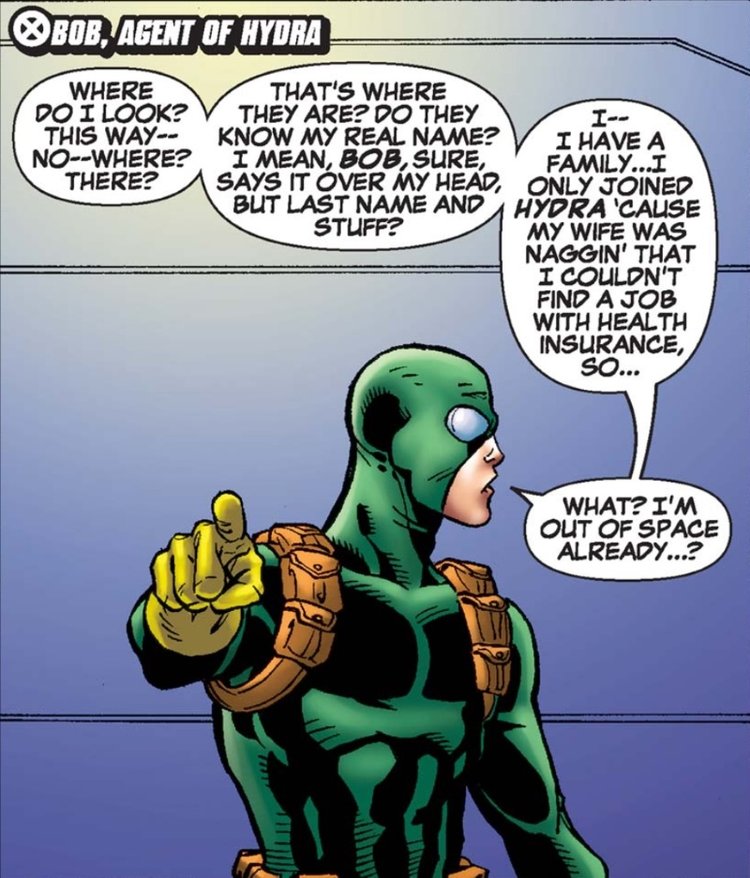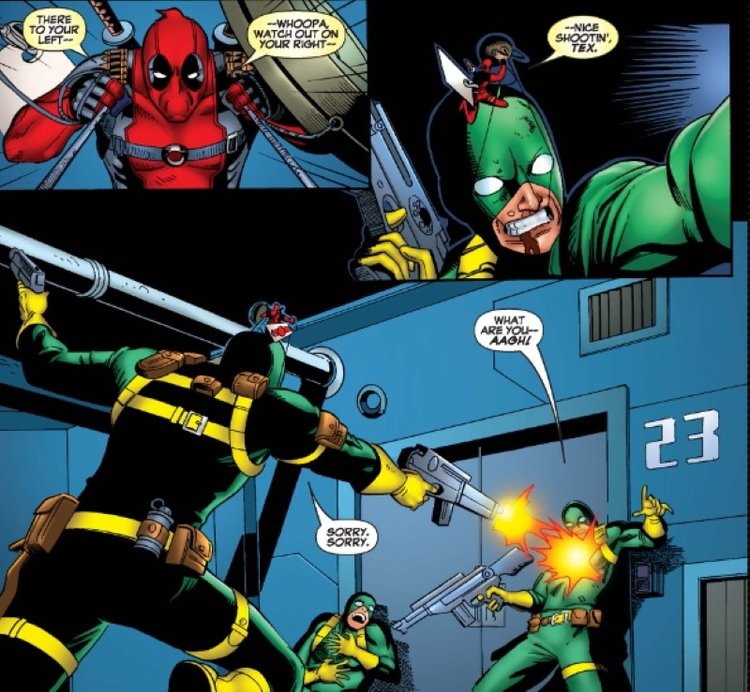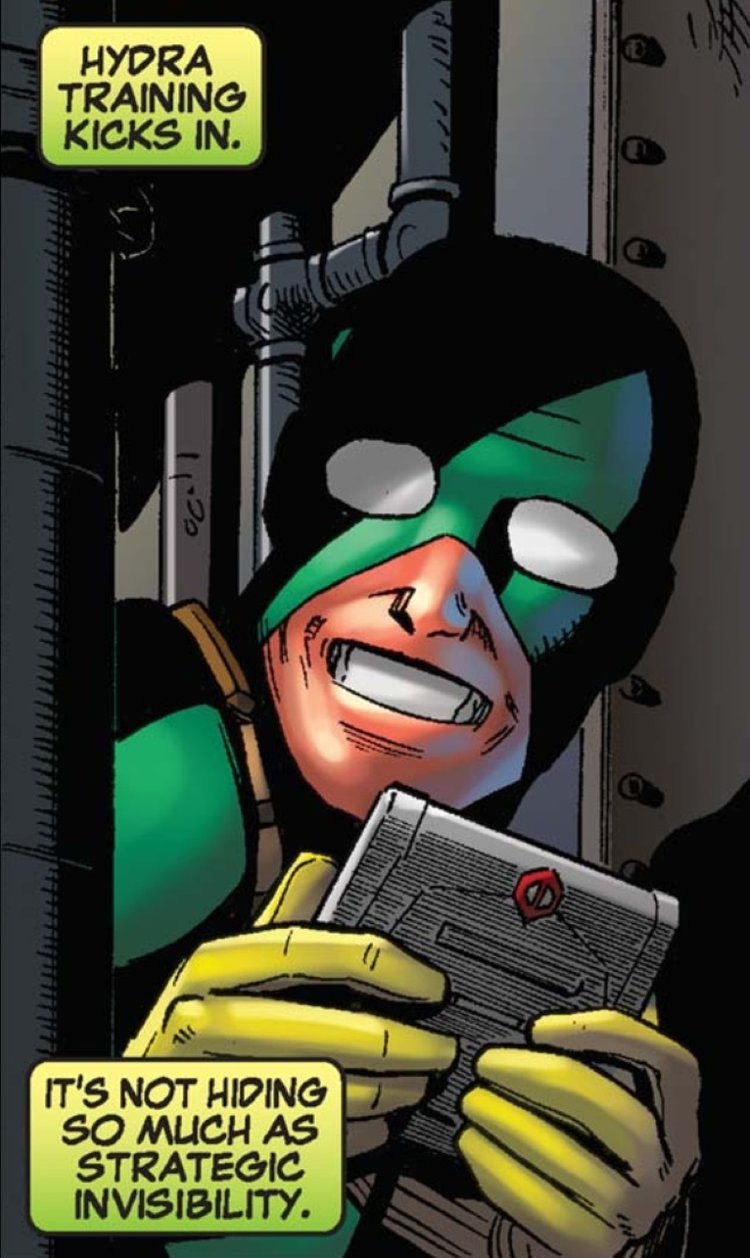The Marvel Universe has always been about the strange, miraculous, uncanny world outside your window. It’s a world of wonder, filled with fantastical heroes and villains alike— filled with remarkable people with power and responsibility thrust upon them.
We will not be talking about those people.
Meet Bob from Hydra. He works there for the dental.

Cable & Deadpool (2004) #43, pencils Ron Lim, inks Jeremy Freeman, colors Gotham
Befriended by Deadpool in the far-flung past of 2007, Bob’s become the unlikely Hydra minion that’s transcended namelessness— where his compatriots choose to fight a hopeless fight, getting tossed around by heroes en masse, Bob has enough of a self-preservation instinct to hide at the first sign of trouble. (It’s probably why he’s shown up more than once at all.)
He’s a thoroughly spineless, entertainingly hapless character, which means, of course, he’s become part of the nightmare that is Deadpool’s supporting cast over the years.

Cable & Deadpool (2004) #48, writer Fabian Nicieza, pencils Reilly Brown, inks Jeremy Freeman, colors Gotham and Sotomayor
In Snap, Bob’s most defining feature (his hapless cowardice) becomes fertile new design space for the game— he’s the first card to directly interact with the Snap mechanic! Like any self-respecting goon, Bob’s equipped with some firepower in that boss bazooka. (It’s standard issue). And because Bob isn’t a self-respecting goon, his effect is… well, you’ll see.

Cable & Deadpool (2004) #46, writer Fabian Nicieza, pencils Reilly Brown, inks Jeremy Freeman and Pat Davidson, colors Gotham
If your opponent is confident enough to Snap, Bob will lose his nerve and run to a new location. And if you’re confident enough to Snap… well, Bob will haplessly bumble into a new location, possibly messing up your own best laid plans. If you’ve ever wanted to feel like a villainous Hydra commander in charge of someone thoroughly inept, this is the card for you!
…But What Does He Do?
Hey— 1/4 is above rate. It’s a big gun! And where cards are above rate, card gamers are always ready to ignore a downside and chase the dream: conditionless stat efficiency!
Another footnote of a minion (look him up!), our old pal Zero has the power to zap that cowardice straight out of Bob’s head. There’s precedent for overstatted 1-Costs with downside, thanks to Martyr and Titania— and while those lovely ladies are predictably stronger than Bob, Bob’s downside is, perhaps, more manageable if you don’t draw Zero. More importantly, redundancy is the name of the game in any list of 12— more targets will make the stat-stick 1-Cost package more consistent, making it easier, even, to maybe run them alongside the Zero’s larger compatriots.
You can also consider his effect as less of a downside. Introducing interaction between board gameplay and Snapping has never happened before— and Snapping is, board-wise, free. Bob is a reliable Move trigger you can pop on demand: Miles Morales is going to be a 1/5 very reliably whenever Bob’s on board, and he’s another avenue to scale cards like Kraven or even Angela.

Cable & Deadpool (2004) #38, writer Fabian Nicieza, pencils Reilly Brown, inks Jeremy Freeman and Pat Davidson, colors Gotham
Ratatouille, eat your heart out.
In Your Own Words, What Would You Consider Your Greatest Weakness?
Sample Bob Shuri
Like the real world, it’s a trick question, and our first test deck does what all the best job interviewees do to navigate it— cover up all those glaring weaknesses by cheating! The classic Sauron-Shuri-Red Skull package already synergizes with Zero and friends, and the Bob will help lend that package redundancy and also give the deck something else it can do in the early turns before its 4-5-6 curve.
We Really Need A Union
Sample Bob Bounce
Our next deck is a bit of a 1-Cost Bounce pile— versions of this idea already run 1-Cost stat sticks like Rocket, and Bob’s less conditional 1/4 may give him an edge in that slot. Bob’s downside is less punishing when you fill your lanes, and even less punishing when he’s in your hand! Managing Beast and Falcon will let us reposition an otherwise flighty Bob, alongside the other small fry— and as a 1-Cost, Bob fits right in with the rest of the package scaling up Bishop, Angela, and Hit-Monkey.
It’s Called A Tactical Retreat
Sample Bob Move
The final deck I’ve personally got in mind might use Bob most effectively: like we’ve already covered above, rather than treat him as a downside, we’re going to take advantage of his ability to trigger Move without any actual resources. We’re hitting all the usual Little Movers staples; it’ll be interesting how Bob both impacts the deck’s power and its cube rate, considering how you’ll have to weaponize your own Snap.

Cable & Deadpool (2004) #45, writer Fabian Nicieza, pencils Reilly Brown, inks Jeremy Freeman, colors Gotham
These are all pretty rough shells, but they might give you a decent starting point; from here, let me know what synergies or ideas you have yourselves down below!
Standard-Issue Uniform
Perhaps predictably, Bob doesn’t have a massive back catalog of existing covers to work with; he’s launching with but two variants: a single Spotlight variant, a custom commissioned piece from none other than Second Dinner fave Pandart Studio, and a Venomized variant that seems similarly commissioned by Second Dinner! The former is dynamic and full of rough energy like Pandart’s last featured outing in AvX, and it’s probably the coolest Bob’s ever looked. (Frankly, most of the commissions for Bob will feature a big gun to justify his statline, so being in Snap might just be the glow-up Hydra Robert here needs). And the latter (while the artists are formally unidentified) feels right up the alley of familiar variant duo Eduardo Mello or Ryan Kinnaird— or, at least, someone working in Second Dinner’s established house style. He looks cool here, too— the wonders a symbiote will do for your confidence.
Verdict
Overall? It’s possible that Bob’s unpredictability becomes less than the downside it seems to be: the ready comparison is Silk, who had very tepid expectations and became a common staple in the Little Movers package. At 1/4, it feels like Second Dinner is pretty aware of that, too— statting him a point lower than other Downside 1-Costs like Titania and Martyr feels like a pointed hint that Bob’s not nearly as punishing as they are.
Besides, look at him. He can’t be that bad, right? Right?

Deadpool: Dracula’s Gauntlet (2014) #5, writer Gerry Duggan, pencils Reilly Brown, inks Nelson Decastro, colors Jim Charalampidis
Bare minimum, Bob is exciting new design space: interacting with the Snap mechanic and injecting some chaos into your games promises a fun and wacky time for any who spring for him! If you’re competitively-minded, I suspect he launches reasonably, but it may be prudent to wait a bit before pulling the trigger— if he ends up playable, it likely happens as a supporting player in existing archetypes, where he will have replacements in a pinch.
Bob’s releasing in a Spotlight Cache alongside Nebula and Galactus: frankly, if you don’t have either of these cards, whether you want Bob or not may be secondary! Nebula is a consistent workhorse 1-Cost that does more than pull her weight in any deck she fits in, and Galactus is a Big Bad that opens up a whole new deck archetype to play.
Their Spotlight variants by Sweeney Boo and Ron Garney and Paul Monts are dope too— here’s hoping we see more from both artists in the game soon!
And I’d end on a flavorfully villainous, Hail Hydra! or something to that effect… but that sort of spirited commitment just doesn’t seem up Bob’s alley.

Cable & Deadpool (2004) #44, writer Fabian Nicieza, pencils Ron Lim, inks Jeremy Freeman and John Dell, colors Gotham and Sotocolor















